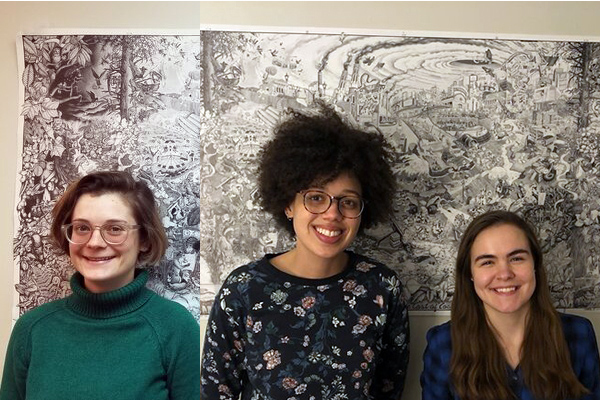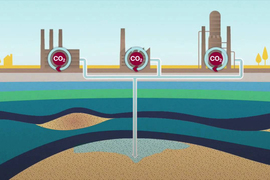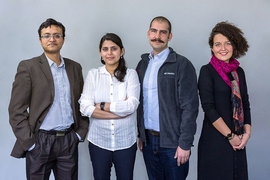More extreme weather, heat waves, and inland flooding are some of the impacts that the state of Pennsylvania expects to see with a changing climate. And scientists and economists agree that, if we don’t quickly reduce the greenhouse gas pollution from fossil fuels like coal and gas that contribute to warming the planet, these impacts will only grow more costly and dangerous.
Yet parts of western Pennsylvania, like many regions of the United States, rely on coal and gas production to support the local economy. Through its Here and Real project, the MIT Environmental Solutions Initiative (ESI) is investigating solutions that reduce carbon pollution and are economically just for communities that are reliant on fossil fuel production.
In a new ESI white paper, the authors highlight the case of Greene County, Pennsylvania, and how equitable solutions need to be about more than creating jobs; they also need to protect schools.
A frontline community for changing energy markets
A roughly 36,000-person county in the southwestern corner of the state bounded on two sides by West Virginia, Greene County sits atop a vast coal bed that stretches from Alabama to northern Pennsylvania. Since 1986, it has been the number one coal mining county in one of the biggest coal-producing states in the country. But, as coal struggles to compete with methane gas prices, Greene County coal production has decreased in recent years.
When most people hear about the decline of coal in the U.S., they picture out-of-work miners. What’s perhaps less obvious is that, in parts of the country where governments count on mines as major taxpayers, like Greene County, this reliance on coal also has affected critical social services, from public schools to senior programs.
In the new white paper, authors at ESI show that the county’s reliance on tax revenues from coal production creates substantial financial risk. They also found that differences in how taxes are collected on coal production versus methane gas (also called natural gas) call into question claims that the shale gas boom could make up for the tax revenue shortfall.
As coal mining wanes, Greene County contemplates its future
While waiting tables after moving back home to Greene County in the wake of the Great Recession, Veronica Coptis heard from customers who felt captive to the coal industry. Coal provided good-paying jobs, but mining also wreaked havoc on the environment — something Coptis, who grew up fishing on a lake that was drained after a mining company ruptured a dam on it, has seen firsthand.
Coptis soon started working at the Center for Coalfield Justice (CCJ), the nonprofit she now heads, to make sure that state regulators enforced environmental regulations on the mining industry. “There was definitely the need to advocate for the environment,” she recalls. “But being from the community, I couldn’t continue just doing environmental advocacy if I wasn’t doing economic justice advocacy as well.”
In 2017, ESI Director John Fernández read a New Yorker profile of Coptis and reached out to explore a collaboration between CCJ and MIT. That year, CCJ had started a community outreach campaign to hear what residents thought about the decline of coal, the rise of methane gas, and the future of Greene County. “People were widely concerned about the jobs,” Coptis says. “But people were also widely aware of how much tax revenue and support comes back to the community from the coal operations that are here.”
Greene County became the first engagement for ESI’s Here and Real project. “Our approach is not for MIT to come in and tell communities, ‘Here’s what we know and here’s what you should do,’” says Laur Hesse Fisher, ESI program director who heads Here and Real. Rather, “we work closely with local partners to conduct research that’s deeply relevant to the community, keeping front of mind the issues that matter most to them.”
The following summer, Fernández and MIT student intern Ben Delhees, a finance and mathematical economics double major, visited western Pennsylvania to learn more about how the decline of the coal industry was affecting the county.
School districts’ heavy reliance on coal taxes proves risky
In the summer of 2018, Delhees worked with data from the Greene County Budget Office to study the local economic and environmental consequences of coal’s departure. Over winter and spring of 2018-2019, MIT students Mimi Wahid and Caroline Boone built upon his research by looking into how declining tax revenues from coal companies impacted school funding. Their internships with CCJ were supported by ESI and the PKG Center.
They uncovered a concerning trend. Some school districts receive over half of their funding from a tax on the value of coal mined, which has declined almost 13% county-wide from 2010 to 2019. One district, Central Greene, saw mineral values decrease by 44% from 2010 to 2018. Even with tax raises, the district still saw mineral revenues go down 32% — a loss of $888,724.
Wahid and Boone worked with the Center for Coalfield Justice to include these findings in the group’s door-to-door canvassing in the county, as well as a series of workshops that CCJ ran over the summer to educate residents on their local tax structure and how it was changing as coal companies leave and petrochemical companies move in. ESI also worked with students at Emerson College’s EnGAgeMEnt Lab to design a hands-on educational game to illustrate this research, that CCJ ran at three summer county fairs.
“Part of what made this project successful was the diverse disciplines of the students,” said Hesse Fisher. Wahid majors in writing and urban planning and studies, while Boone majors in mechanical engineering, adding to Delhees’ focus on finance and mathematical economics and White-Nockleby’s anthropology studies. “Their different perspectives strengthened both the research and how we engaged with the community.”
Authors find methane gas “can’t replace coal”
Caroline White-Nockleby, a graduate student in MIT’s Doctoral Program in History, Anthropology, and Science, Technology, and Society, expanded upon their work by looking into how coal’s decline was impacting real estate tax revenues, and the extent to which the shale gas boom could offset those losses. Her research culminated in a white paper synthesizing all this information into a complete picture of Greene County’s tax structure, public services, and vulnerabilities as the coal industry declines.
Hydraulic fracking — the process used to extract methane gas from shale — has soared in the past decade with 870 active wells in the county. To help make up for lost coal revenue, school districts have been using funds from a fee charged on these wells. But this is not a long-term solution, according to the white paper, because those revenues are so much lower than what was coming in from the coal mines.
“There’s a narrative that money from fracking would be able to replace some of the money from coal extraction,” says White-Nockleby. “But actually, if you look at the numbers, that's really not what's happening. ... You can project that within three years, they're not going to be able to fill the budget gaps.”
Greene County’s real estate tax revenue has also taken a hit. While coal companies remain the largest property taxpayers in the county, White-Nockleby found that property taxes paid by the largest coal companies fell from $5.2 million in 2015 to $3.1 million in 2019. And while there was some hope that increased methane gas production would offset this decline, methane gas companies pay much less in real estate taxes. “Gas basically can’t replace coal, and it has its own huge suite of environmental impacts,” White-Nockleby says.
The consolidation of Greene County’s revenue base among a small number of actors in which coal companies figure heavily, combined with the past and projected decline of the industry, poses a distinct financial risk — one that has been noted by the Global Credit Portal, the organization that rates the financial stability of the county’s municipal bonds.
Coptis, from the Center for Coalfield Justice, says the MIT tax analyses armed her group and other community members with the data needed to convince school board members and local officials to anticipate, rather than react to, mine closures.
“Let's start making the plan now to figure out [what] alternative revenue sources to build,” she says. “Because what these communities can't withstand … is an increase in tax rates to cover the cost of an industry that bails on the community.”
Next, ESI and CCJ are bringing these findings to county and state officials, as well as other communities going through similar transitions.
“It is imperative to slow climate change, and we need to take care of people as we lower emissions,” says Hesse Fisher. “This paper has shown that we also need to look at the broader fiscal impacts of the energy transition. We hope this work can support states and communities as they plan for a resilient future.”









